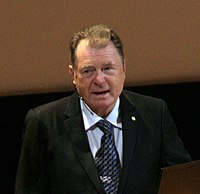Richard Fred Heck (born August 15, 1931) is an American chemist noted for the discovery and development of the Heck reaction, which uses palladium to catalyze organic chemical reactions that couple aryl halides with alkenes.

Heck was jointly awarded the Nobel Prize in Chemistry on October 6, 2010, with the Japanese chemists Ei-ichi Negishi and Akira Suzuki, for their work in palladium-catalyzed coupling reactions in organic synthesis.
Heck was born in Springfield, Massachusetts in 1931. He earned both his bachelor's degree (1952) and his doctor of philosophy degree (1954) at the University of California, Los Angeles (UCLA), working under the supervision of Dr. Saul Winstein. After two periods of postdoctoral research at the ETH in Zurich, Switzerland, and then back at UCLA, Heck took a position with the Hercules Corporation in Wilmington, Delaware in 1957. After productive research work at Hercules, he was hired by the University of Delaware's Department of Chemistry and Biochemistry in 1971. Heck was a professor of chemistry at the University of Delaware.
The development of the Heck reaction began with Heck's investigations of the coupling of arylmercury compounds with olefins using palladium as a catalyst during the late 1960s. This work was published in a series of seven consecutive articles in the Journal of the American Chemical Society (JACS) for which Heck was the sole author.
During the early 1970s Mizoroki independently reported the use of the less toxic aryl halides as the coupling partner in the reaction.and Heck During his career, Heck continued to improve the transformation, developing it into a powerful synthetic method for organic synthesis.
The importance of this reaction grew slowly in the organic synthesis community. In 1982, Heck was able to write an Organic Reactions chapter that covered all the known instances in just 45 pages.By 2002, applications had grown to the extent that the Organic Reactions chapter published that year, limited to intramolecular Heck reactions, covered 377 pages. Today, the Heck reaction stands as one of the widely used methods for the creation of carbon-carbon bonds in the synthesis of organic chemicals. This reaction has been subject to numerous scientific review articles, including a ~600 page monograph dedicated to this subject published in 2009.
Heck's work set the stage for a variety of other palladium-catalyzed coupling reactions, including those of aryl halides with derivatives of boronic acid (Suzuki–Miyaura coupling), organotin reagents (Stille coupling), organomagnesium compounds (Kumada-Corriu coupling), silanes (Hiyama coupling), and organozincs (Negishi coupling), as well as with amines (Buchwald–Hartwig amination) and alcohols. These palladium-catalyzed coupling reactions are now widely practiced in organic synthesis, including in the chemical engineering production of certain organic compounds in factories.
Of the several reactions developed by Heck, the greatest societal impact has been from the palladium-catalyzed coupling of an alkyne with an aryl halide. This is the reaction that was used to couple fluorescent dyes to DNA bases, allowing the automation of DNA sequencing and the examination of the human genome. In Sonogashira's original report of what is now known as the Sonogashira coupling, his group modified an alkyne coupling procedure previously reported by Heck, by adding a copper(I) salt.
Heck's contributions are not limited to the activation of halides by the oxidative addition of palladium. Heck was the first to fully characterize a π-allyl metal complex, and the first to elucidate the mechanism of alkene hydroformylation. Hydroformylation is currently used to produce about 15 billion pounds of alcohols and aldehydes each year.Heck retired from the University of Delaware in 1989, where he remains Willis F. Harrington Professor Emeritus in the Department of Chemistry and Biochemistry. Its annual lectureship was named in his honor in 2004. In 2005, he was awarded the Wallace H. Carothers Award, which recognizes creative applications of chemistry that have had substantial commercial impact. He was awarded the 2006 Herbert C. Brown Award for Creative Research in Synthetic Methods.On 6 October 2010, the Swedish Royal Academy of Sciences awarded Heck the Nobel Prize in Chemistry. He shared the 2010 Nobel Prize with Ei-ichi Negishi and Akira Suzuki "for palladium-catalyzed cross couplings in organic synthesis." In 2011, Heck was awarded the Glenn T. Seaborg Medal for his work on palladium-catalyzed cross couplings.
Richard Heck now resides in the Philippines
No comments:
Post a Comment